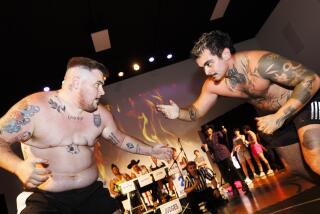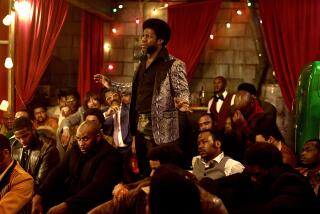Battle of the bulls, nicely
- Share via
GUSTINE, CALIF. — The well-coiffed Portuguese matador, muttering provocations in his native tongue, sizes up his weighty opponent’s slavering mouth and sloping horns. In his hand he flashes his weapon: a bandarilha tipped not with razor-sharp darts but with nonlethal Velcro. The bull makes no distinction.
Spectators’ voices drop to murmurs. Overhead lights sparkle off the matador’s gold sequins, and the smell of linguiça (sausage) perfumes the dusty air. This suspended moment could be a summer night in the Azores -- until the matador lurches toward the advancing beast and, with a graceful twist of his body, artfully sticks the strip of Velcro between the bull’s shoulders. A brass band launches into a triumphant score, and I join 4,000 aficionados in an eruption of “¡Ole!” that rocks this creaky bullring in the San Joaquin Valley.
On Monday nights, between March and October, Mexican and Portuguese performers routinely headline “bloodless” bullfights in the nine or so bullrings in remote Central Valley hamlets such as Riverdale, Thornton and Stevinson.
The events are a legacy of the early rancho days, from the Spanish tradition inherited by Mexican settlers. In 1957, California banned gory bullfights but did allow supporters -- mostly Portuguese dairy farmers from the Azores, where the sport is popular and bloodless -- to continue the tradition as long as the bull isn’t harmed or killed, and contests were staged in conjunction with religious festivals.
The Velcro adaptation was introduced in 1980 by Dennis Borba, an American-born matador whose father, Frank, was one of a few pioneering immigrants to revive the old-world spectacle in the 1960s. Their innovation was a unique hybrid that combined the horseback fighting central to the Portuguese tradition with the on-their-feet matadors in the Spanish style.
The fights remained amateurish until local ranchers began crossing domestic cows with Mexican “brave” bulls. Then came the Velcro, for new-world sensibilities.
Curiosity drove three friends and me up Interstate 5 to Gustine last fall on the concluding night of Our Lady of Miracles Festa, the year’s largest Catholic celebration. During the weekend, cow-drawn cart parades, folk dances and communal feasts had transformed the sleepy, tree-lined streets of this agricultural town of 5,300 into an Azorean carnival.
The Praça de Touros is on the outskirts. When we arrive, the dirt parking lot is full and cars stretch down the adjacent alfalfa field. The scene is more wedding reception than pregame tailgate: Couples are shuffling to slow, Portuguese ballads on a makeshift dance floor outside; reunited friends mingle and gossip, snacking on traditional food, such as pregos (pork sandwiches), from a wooden stand.
The plain, maroon-colored siding around the ring lacks any sign of corporate sponsors or advertisers. In the tiered stands, we take seats next to five, convivial sisters in their 60s, who had convened from points across the state for a night out.
The evening happens to be Sept. 11, and so the fight begins with a patriotic commemoration led by the mounted Merced County Sheriff’s Posse, a reminder of the country we are in.. The first act features cavaleiros, men renowned for their agile horsemanship. Luis Rouxinol, regarded as one of Portugal’s best, trots into the ring on a handsome quarter horse, outfitted like one of the Three Musketeers in an embroidered, 18th century-style frock coat, ruffled shirt and a triangular, white-feathered hat. He dances his horse around the ring for us to admire its technical prowess, offers his hat to a dignitary and signals his readiness to fight.
The bulls in these corridas -- six in each fight -- have been bred for this moment. After tonight, most are retired to the rodeo -- or the slaughterhouse. Rouxinol’s challenger bolts into the ring, disoriented.
The cavaleiro steers his stallion toward the excited animal, provoking a brief chase designed to study the bull’s movements and display the steed’s skillful evasion of its piercing horns, which have been sheathed in protective leather. After a few of these runs, Rouxinol stops to face the bull, pauses and raises a tasseled, Velcro-tipped lance. The bull charges, the horse mirrors the advance, and the two head on a collision course until the horse makes a last-second sidestep around the bull, enabling Rouxinol to angle the bandarilha squarely onto the bull’s shoulder.
Act 2. Bugles herald the arrival of eight men who climb into the ring dressed as a cliché of a French waiter: red, bolero jackets fit snugly over white shirts and red ties; tight brown knickers meet white, knee-high socks. Single file, they steadily advance to within 10 yards of the bull, while the lead man -- who wears a floppy, green elf hat in a style descended from Portuguese fishermen -- hollers, “Toiro, oi!”
Because the ring announcer is speaking in Portuguese, my friend Emmet asks a neighbor, a lifelong fan of the bullfights, what people call this group of jesters. “Stupid!” the man says with a laugh, and takes another gulp of beer.
They’re actually forcados, named after the pitchfork the men traditionally wielded to protect attending royals from an errant bull. Unique to Portuguese bullfighting, this group from Turlock is known as the Suicide Squad -- and indeed what follows could have been a scene from the movie “Jackass.”
The bull, now provoked, drops its head and charges the lead forcado. The crowd gasps. The forcado leaps on top of its broad shoulders and grabs its neck in a chokehold. His comrades rush to smother the animal in a rugby-like scrum.
As they subdue the bull -- and the arena crowd goes berserk -- the eldest forcado grabs the animal’s tail and digs his heels into the dirt like a water skier.
The others release the bull and saunter off, leaving it to spin madly for its tail, while the forcado tries to hold steady. Perhaps realizing the futility of this circular chase, the bull eventually collapses into the dirt like a sprawled cat -- a symbolic death.
The forcado drops the tail and takes a few steps away before stopping to glare emphatically over his shoulder at the vanquished animal.
Raucous laughter around me overwhelms any sympathy I may have for the bull right now. A herd of bony cows trots into the ring clanging bells, and the bull instinctively rises to join them -- departing into retirement alive, perhaps, but thoroughly emasculated.
Rouxinol and the elf-capped forcado walk the perimeter of the ring like victorious sprinters, receiving caps and wineskins from the crowd, before stopping at the VIP section to accept a bouquet of flowers from the teenage festa queen.
At this point, our neighbors are offering us beer and sausages, and Emmet is on his feet, hands above his head, leading the sisters and the rest of our section in the wave that rounds the arena. The intimacy is something between a rodeo and a minor league baseball game. But rather than grumblings about stray pitching, the prevailing chatter is of lame bulls.
This sentiment is palpably heightened at the beginning of the third, and final act, as matador Vitor Mendes takes the ring. His glowering adversary enters and immediately charges one of the assisting banderilleros, whose function is to test the bull and allow the matador to study its movements. The banderillero finds safety behind a wooden barrier, but the momentum causes the bull to flip over the barrier wall around the ring and into the corridor where the performers stand.
Bystanders jump into the ring as the bull barrels wildly down the corridor past the front row, inciting pandemonium. Our pulses racing, we feel, for a moment, the sport’s interplay between artistry and mortality. Indeed, a woman behind us says she has seen two matadors die in this ring.
Handlers redirect the bull back into the ring, and the matador dances an elegant pasodoble with the animal, striking dignified poses with his red cape through which the animal passes, as if it had been staged.
For the Portuguese American community, the bullfights have become a social nucleus and serves to preserve a distant cultural heritage. Back in the Azores, romances are often kindled at these celebrations.
Here, after the main event, the pulsing dance floor outside becomes a cobblestone plaza in the old country. Teenage boys cluster on the perimeter, scoping girls; their parents mingle in the background. It’s a tempting finale -- but we have a long drive home.
--
(BEGIN TEXT OF INFOBOX)
The toro tradition
Bullfights are held in California from March to October. Many are in small towns of the San Joaquin Valley, such as Gustine, about 280 miles north of Los Angeles. But some venues are much closer. In honor of the Festa do Divino EspÃrito Santo, there’s a bullfight at 6 p.m. Monday at 11903 Ashworth St., Artesia. Tickets cost $25 for adults, $12 for children ages 6 to 12, free for ages 5 and younger. Call (562) 865-4693. For a list of upcoming bullfights, go to www.california.
More to Read
Sign up for Essential California
The most important California stories and recommendations in your inbox every morning.
You may occasionally receive promotional content from the Los Angeles Times.










